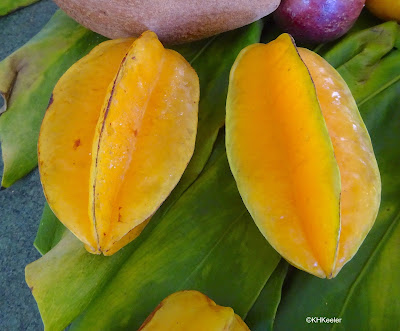Star fruit is a distinctive fruit, appearing occasionally in northern U.S. tables. It is easy to learn to call it star fruit, since in cross section, it forms a yellow star.
 |
| Star fruits, carambolas, Averhoa carambola |
The genus name, Averrhoa, refers to Abū l-Walīd Muḥammad Ibn ʾAḥmad Ibn Rušd, 1126-1198, a Muslim philospher, physician and jurist (bio) whose writings were very important in both the Muslim and Christian worlds of his time and thereafter. More often called Ibn Rushd, even that name was incomprehensible to the Christian community, who called him Averroës. You can see how Ibn Rushd could become Averroës (the umlout, ë, means there are two syllables there o es) despite the fact that the spelling is wildly different. Linnaeus chose to name the genus that includes carambolas for Ibn Rushd/Averroës. I do not know of any connection between the philosopher and the tree other than that Linnaeus wanted to honor Averroës. But that is where that odd genus name comes from.
There are several varieties of star fruit, from quite sour to relatively sweet. The acid in the fruits is mostly citric acid, though there is enough oxalic acid to impart that acid's characterist sourness and flavor. (Note that oxalic acid was named and identified from plants in this plant family). Oxalic acid is present in the fruits and, since concentrated oxalic acid is toxic, be wary of eating many strongly sour fruits. However, most of the oxalic acid the poisoning cases I could find were due to consuming oxalic acid-rich cleaning products, not star fruits. It does pose a risk to uremic patients and people with kidney problems.
Star fruits are rich in vitamins and in sugars. The fruits are eaten raw or cooked, in salads, drinks, pastries, and preserves. Raw, they have a pleasant crunchiness, reminiscent of an apple, leading to another English common name, star apple. In cooking they are often included as a souring agent, so less sweet varieties are preferred, or if those are unavailable, unripe fruits. They are shipped to northern markets, and, as with most shipped fruits, are blander and sourer than when eaten close to where they grew.
In addition to being eaten, star fruits have a long history as medicinals. They were used in Chinese and Ayurvedic medical traditions and folk medicines of the Americas to treat conditions from chronic headache to ringworm infections, and skin inflammations. Modern science finds them to be rich in antioxidants, anti-inflamatory, and anti-microbial (link).
The acids in the fruit make it effective as a stain remover, for both skin and cloth, and the fruits will polish brass.
Of course star fruits have rich folklore. Here's a link to a tale from Vietnam: The Star Fruit Tree. Take a look!
 |
| star fruits |
This is a interesting and readily-recognized tree and fruit, watch for them.
Comments and corrections welcome.
References
Ho Din Hai. Introduction to the species Averrhoa carambola the starfruit tree. The Worldwide
Vegetables. link Accessed 2/13/21.
Kiple. K. F. and K. C. Ornelas. 2000. The Cambridge world history of food. Cambridge University Press, London.
Morton, J. 1987. Carambola. p. 125–128. In: Fruits of warm climates. Julia F. Morton, Miami, FL. at
New Crop, Purdue University link Accessed 2/13/21.
Missouri Plant Finder. Averrhoa carambola. Missouri Botanical Garden. link. Accessed 2/12/21.
van Wyck, B-E. 2005. Food plants of the world. Timber Press, Portland, OR.
Vaughan, J. G. and C. A.Geissler. 1997. The new Oxford book of food plants. Oxford University Press, London.
Zuchowski, W. 2007. Tropical plants of Costa Rica. Comstock/Cornell Paperbacks, Ithaca, NY.
Kathy Keeler, A Wandering Botanist
More at awanderingbotanist.com
Join me on Facebook: https://www.facebook.com/AWanderingBotanist


No comments:
Post a Comment